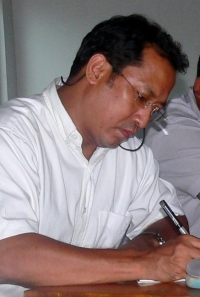| Home - Back Issues - The Team - Contact Us |
 |
| Volume 10 |Issue 36 | September 23, 2011 | |
|
|
Interview A Chat with a King Up close and personal with Chakma Raja Barrister Debashish Roy
Zannatul Ferdous Can you tell us a little about the history of the Chakma Circle Chiefs (Raja) of the CHT? Early history says that the Chakma Rajas descended from the Sakya, the people to which Gautama Buddha belonged. The Chakma people themselves are believed to have originated from a place called Champaknagar. There are references to the Chakma Raja in the Chittagong Hill Tracts (CHT) region in Mughal accounts as early as the 1400s. Portuguese cartographers and historians refer to the country of Chacomas within Chittagong-CHT in the 1550s, as a place separate from Bengal, Arakan and Tripura. According to one account, I am the 48th Chakma Raja, and according to another, the 51st. One of my direct ancestors in the male line was Ranu Khan Dewan, who led the Chakmas in their war of resistance against the British East India Company in the 1780s. What are your interests? I am generally energetic. Some have described me as restless. I like travelling to settlements of indigenous communities in different parts of the world; especially mountains, hills and forest peoples; the remoter the better. Also trekking, photography (still and video), watching theatre plays, singing, playing musical instruments and archiving traditional music. As a student, I participated in several games and sports, including traditional indigenous sports. Can you talk about your work with the Adivasis? I want to strengthen the organisational capacities of Adivasi peoples, so they are able to protect their distinct and diverse cultural identities, their integrity as peoples, their basic human rights and fundamental freedoms. In today's age of globalised capitalism, a lot of the rich indigenous cultural heritage is getting buried amidst an overwhelming practice of more 'popular' dominant cultures. For example, a Khumi, Chak or Khyang child sitting in a remote hill-top village of CHT, has no opportunity of seeing her/his own people's cultural heritage, as the educational curriculum or media, national or international television or radio has little or no coverage of the people's culture. What is your vision of Adivasi children's education? Adivasi child education in her/his mother tongue is the only way that a child can start her or his education in an atmosphere in which she/he is at ease, comfortable, happy and confident. I remember my discomfiture at my first days in an English-medium school in Chittagong, where the headmistress addressed me in Urdu or English. I was terrified and till today I remember having to learn in that hostile and alien environment which is extremely harmful to a child's self-confidence. The national language and other languages should only be introduced progressively. Local NGO experience in mother tongue –based multilingual education, in primary schools of Khagrachari has shown higher performance of Adivasi students and lower dropouts than mono-Bangla language schools. Adivasi students starting off in the mother tongue were also seen to speak Bengali better than those who were suddenly exposed to Bengali at too early an age. The issue of script, however, is a different matter. Traditional or adopted scripts can be introduced at a later age. What do you think about the Adivasi cultural heritage and Bengali cultural heritage? Is it inevitable that they should be in conflict with each other? Among the greatest strengths of Adivasi cultural heritage are the values about protecting the weak and respecting ecology. It is no coincidence that some of the largest forest areas of the country are located in Adivasi-inhabited territories. Adivasis have a rich store of dance, song, music, and sports. Bengalis have a rich heritage of secularist political traditions and philosophies, music, dance and literature. Over the centuries, Bengalis and Adivasis have had instances of both conflict and cooperation and friendship. The muslin heritage of Bangladesh is an example of Adivasi-Bangali cooperation. Adivasis supplied the cotton from their Jums, and Bengalis spun it into muslin and other yarn. Both Adivasis and Bangalis have an earthy sense of humour. Current Adivasi languages borrow Bengali words. In earlier times, Bangla borrowed generously from Adivasi languages. These symbiotic Adivasi-Bangali ties need to be promoted.
Copyright (R) thedailystar.net 2011 |
||
